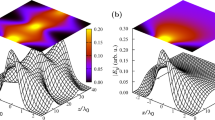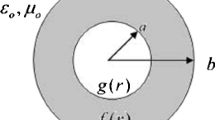Abstract
In this paper, the transient responses of some devices which are based on transformation electromagnetics are studied, such as invisible cloaks and concentrators, by using the Finite-Difference Time-Domain (FDTD) numerical technique. In particular, effects of the inherent losses as well as the coating size of the ideal cylindrical cloak on its bandwidth and cloaking performance are examined. In addition, it is demonstrated that the performance of transformation electromagnetics based devices is affected by the material parameters in the design, although they may behave nicely under monochromatic plane wave illuminations. The obtained results are of interest for the future practical implementation of these structures.
Similar content being viewed by others
References
J.B. Pendry, D. Schurig, D.R. Smith, Controlling electromagnetic fields. Science 312, 1780–1782 (2006)
U. Leonhardt, Optical conformal mapping. Science 312, 1777–1780 (2006)
D. Schurig et al., Metamaterial electromagnetic cloak at microwave frequencies. Science 314, 977–980 (2006)
H. Chen, C.T. Chan, Transformation media that rotate electromagnetic fields. Appl. Phys. Lett. 90, 241105 (2007)
M. Rahm et al., Design of electromagnetic cloaks and concentrators using form-invariant coordinate transformations of Maxwell’s equations. Photonics Nanostruct. Fundam. Appl. 6, 87–95 (2008)
Y. Zhao, C. Argyropoulos, Y. Hao, Full-wave finite-difference time-domain simulation of electromagnetic cloaking structures. Opt. Express 16(9), 6717–6730 (2008)
B. Zhang et al., Rainbow and blueshift effect of a dispersive spherical invisibility cloak impinged on by a nonmonochromatic plane wave. Phys. Rev. Lett. 101, 063902 (2008)
B. Ivsic, Z. Sipus, S. Hrabar, Analysis of uniaxial multilayer cylinders used for invisible cloak realization. IEEE Trans. Antennas Propag. 57(5), 1521–1527 (2009)
C. Argyropoulos, Y. Zhao, Y. Hao, A radially-dependent dispersive finite-difference time-domain method for the evaluation of electromagnetic cloaks. IEEE Trans. Antennas Propag. 57(5), 1432–1441 (2009)
S.A. Cummer et al., Full-wave simulations of electromagnetic cloaking structures. Phys. Rev. E 74, 036621 (2006)
A. Taflove, Computational Electrodynamics: The Finite Difference Time Domain Method (Artech House, Norwood, 1995)
V. Podolskiy, E. Narimanov, Near-sighted superlens. Opt. Lett. 30, 75 (2005)
C. Argyropoulos et al., Manipulating the loss in electromagnetic cloaks for perfect wave absorption. Opt. Express, 17(10), 8467–8475 (2009)
A. Alù, N. Engheta, Cloaking a sensor. Phys. Rev. Lett. 102, 233901 (2009)
Author information
Authors and Affiliations
Corresponding author
Rights and permissions
About this article
Cite this article
Argyropoulos, C., Kallos, E. & Hao, Y. Bandwidth evaluation of dispersive transformation electromagnetics based devices. Appl. Phys. A 103, 715–719 (2011). https://doi.org/10.1007/s00339-010-6206-y
Received:
Accepted:
Published:
Issue Date:
DOI: https://doi.org/10.1007/s00339-010-6206-y




